C. W. Thornthwaite facts for kids
Charles Warren Thornthwaite (born March 7, 1899 – died June 11, 1963) was an American geographer and climatologist. He is famous for creating the Thornthwaite climate classification, a way to group different climates around the world. This system was updated in 1948 and is still used today. He also did important work on how much water plants release into the air, called potential evapotranspiration.
Thornthwaite was a professor of climatology at Johns Hopkins University. He was also an adjunct professor at Drexel University. He led the Commission for Climatology of the World Meteorological Organization. He received awards like the Outstanding Achievement Award from the Association of American Geographers and the Cullum Geographical Medal from the American Geographical Society.
Contents
Early Life and Education
Charles Warren Thornthwaite was born in Bay City, Michigan. He went to Central Michigan Normal School and graduated in 1922. For the next two years, he taught high school in Owosso, Michigan. During this time, he also took classes at the University of Michigan.
In 1924, Thornthwaite moved to California. He began studying at the University of California, Berkeley for his advanced degrees. He worked with a well-known geographer named Carl Sauer. In 1925, he moved to Kentucky to work on his Ph.D. paper. For five years, he worked part-time as a geographer for the Kentucky Geological Survey.
Career in Oklahoma
In 1927, Thornthwaite moved to Oklahoma. He became an assistant professor in the geography department at the University of Oklahoma. He taught many courses there from 1927 to 1934.
While in Oklahoma, he wrote his first article about climate in 1929. It was called "The Polar Front and the Interpretation and Prediction of Oklahoma Weather." He also became very interested in the climate of the Great Plains region. He wrote a review about it for the Geographical Review in 1932.
Doctoral Work and New Ideas
Thornthwaite earned his Ph.D. in geography from the University of California, Berkeley, in 1930. His main research was about Louisville, Kentucky. He studied the city's urban geography using photos from planes, field observations, and detailed maps. Even though he later focused on climate, his research methods were very advanced for his time.
At Central Michigan Normal School, Thornthwaite became good friends with John Leighly. They both later studied at Berkeley, and Leighly became his mentor. Leighly, who was a professor at UC Berkeley for 62 years, later wrote Thornthwaite's obituary.
Developing Climate Classification
In 1931, Thornthwaite published an important paper called “The Climates of North America: According to a New Classification.” This paper started his career as a climatologist. It connected the study of climate with geography. His new classification system was inspired by the Köppen climate classification system. He learned about the Köppen system at UC Berkeley. While in Oklahoma, he began to see its weaknesses.
He decided to create a new system that would work well for North America. Thornthwaite believed that the "effectiveness" of temperature and precipitation was more important than just measuring them. Effective temperature meant how much plant growth resulted from the temperature. Effective precipitation depended on both the amount of rain and how much water evaporated.
Thornthwaite created the P-E index to measure precipitation and evaporation. He collected data from April to September at 21 stations in the United States. He also tried to create a T-E index for temperature effectiveness. This equation set the northern limit of the tundra at zero and the limit of the tropical rainforest at 128. There were six temperature zones in between. The T-E index was a bit complex, so it wasn't used as often.
After publishing this paper, Thornthwaite started applying his classification system worldwide. He gathered data from over 4,000 stations to create a world map. This map was more logical than the previous Köppen map, but it was also quite complicated and did not become widely popular. In 1934, he left the University of Oklahoma to study how people moved within the United States at the University of Pennsylvania.
Government Work and Laboratory
In 1935, he became the chief of the climate and physiographic research division. This was part of the U.S. Soil Conservation Service in the U.S. Department of Agriculture. This division stopped operating in 1942, but he stayed with the USDA until 1946. During this time, he co-wrote an important bulletin with Benjamin Holzman. It was called Measurement of Evaporation from Land and Water Surfaces.
After leaving the government in 1946, Thornthwaite opened the Laboratory of Climatology. This lab was in Seabrook, New Jersey. He ran it until his death in 1963. The lab continued its work under the management of John Russell Mather.
One of his first papers from this lab became his most referenced work. It was "An Approach Toward a Rational Classification of Climate" (1948). Scientists across North America and around the world used this paper. It included information on evapotranspiration, temperature, and precipitation. It is still widely used to study different animal species and the possible effects of climate change.
Water Balance and Later Career
John Russell Mather worked with Thornthwaite on their 1955 monograph called "The Water Balance." This was Thornthwaite's second major contribution to climatology, after his Rational Classification. The water budget was a simple way to estimate water surpluses and runoff. It also helped estimate how much water would refill an aquifer (underground water source).
Thornthwaite was a professor of climatology at Johns Hopkins University from 1947 to 1955.
Personal Life
Charles Thornthwaite married Denzil Slentz in 1925. They had three daughters. After his wife passed away in 1962, he created the Charles Warren and Denzil Slentz Thornthwaite Memorial Scholarship Fund. This fund gives annual scholarships to students studying meteorology (weather) and earth science at Central Michigan University.
See also
 In Spanish: Charles Warren Thornthwaite para niños
In Spanish: Charles Warren Thornthwaite para niños


